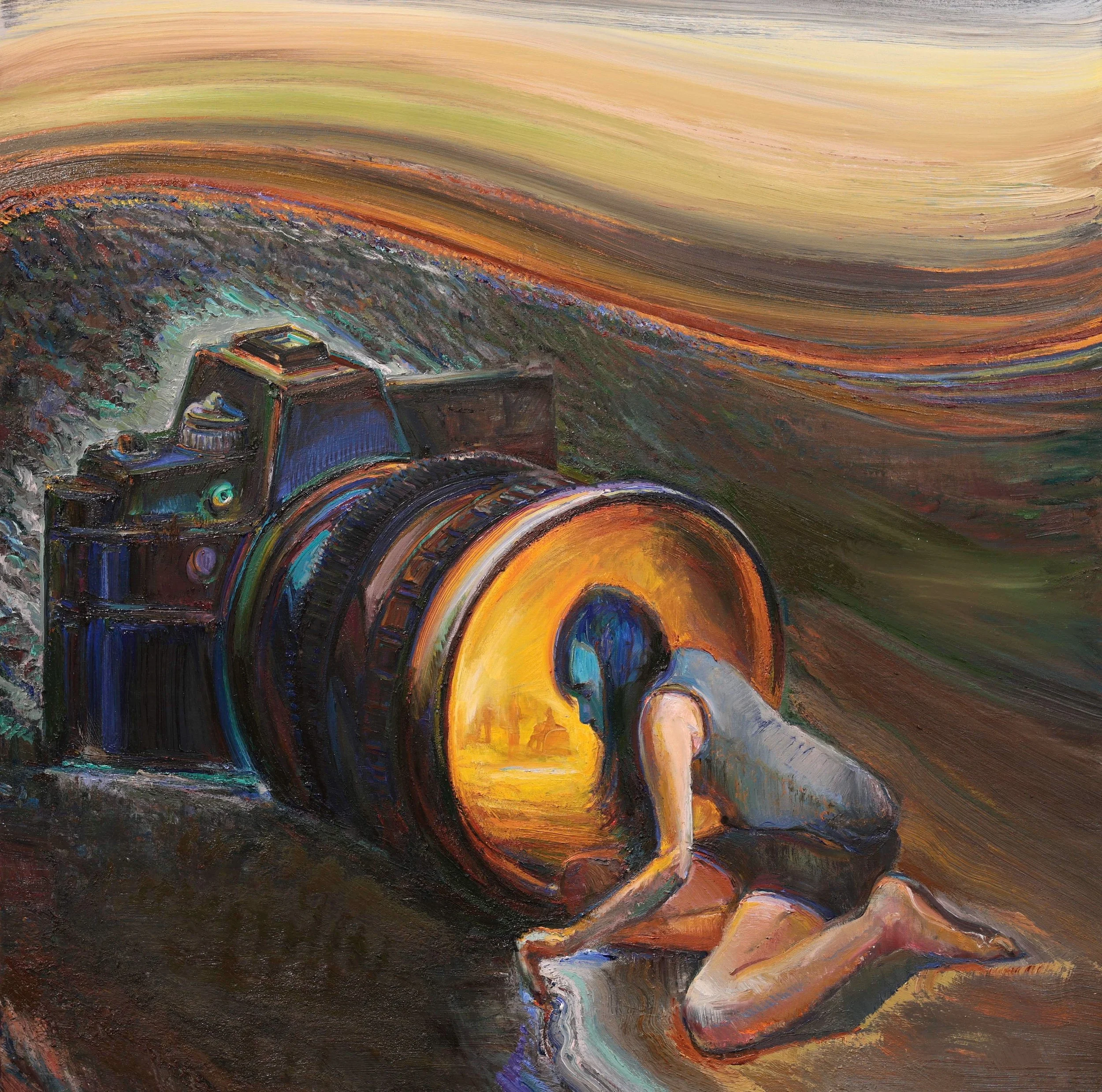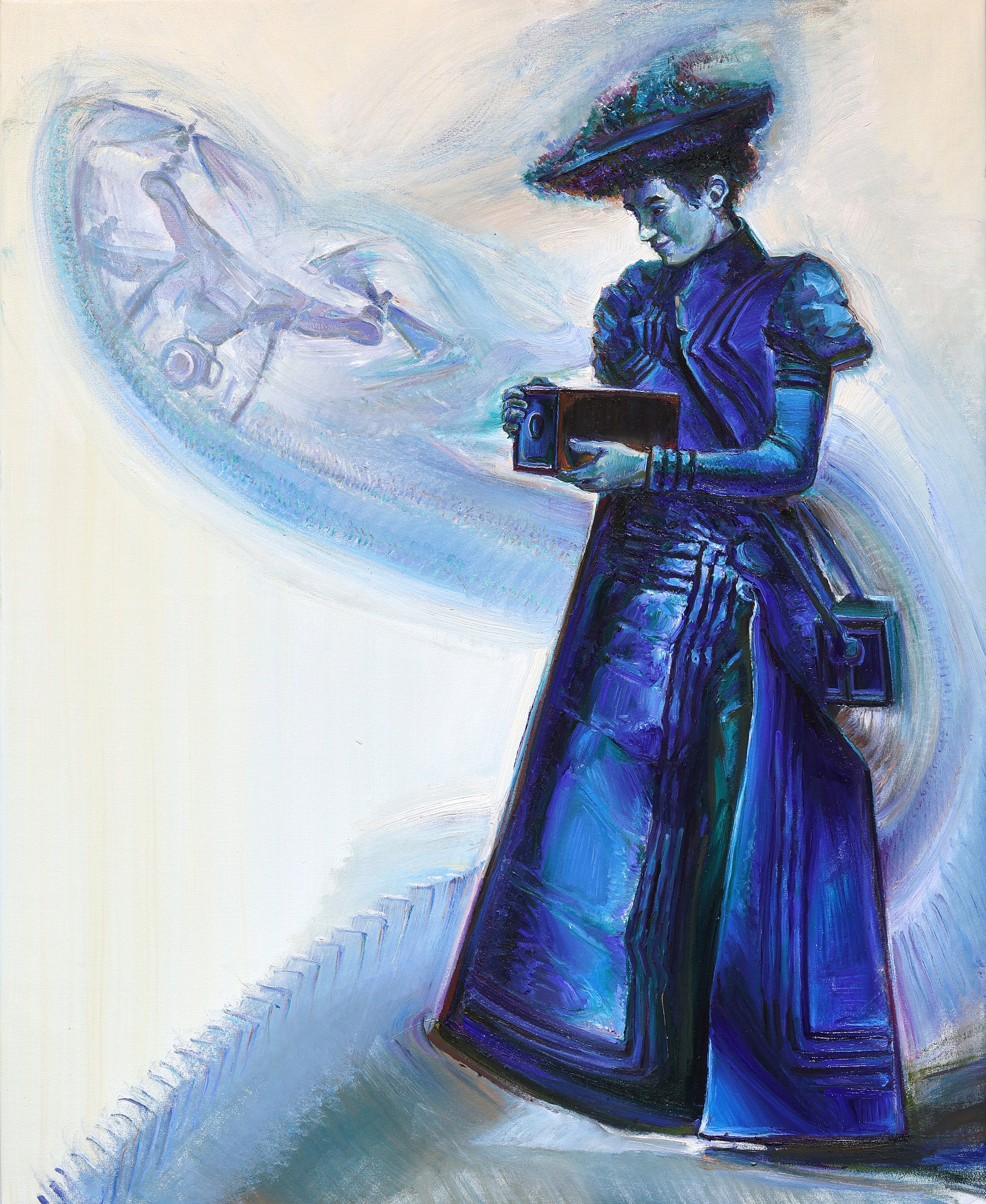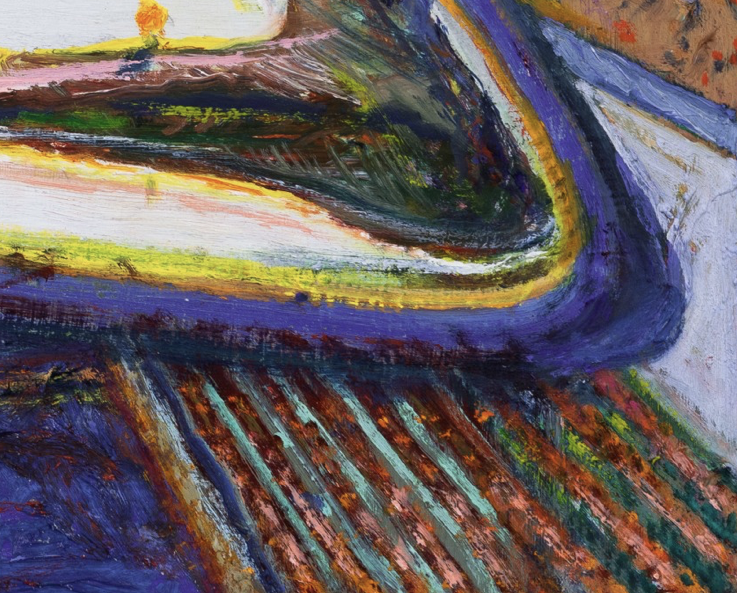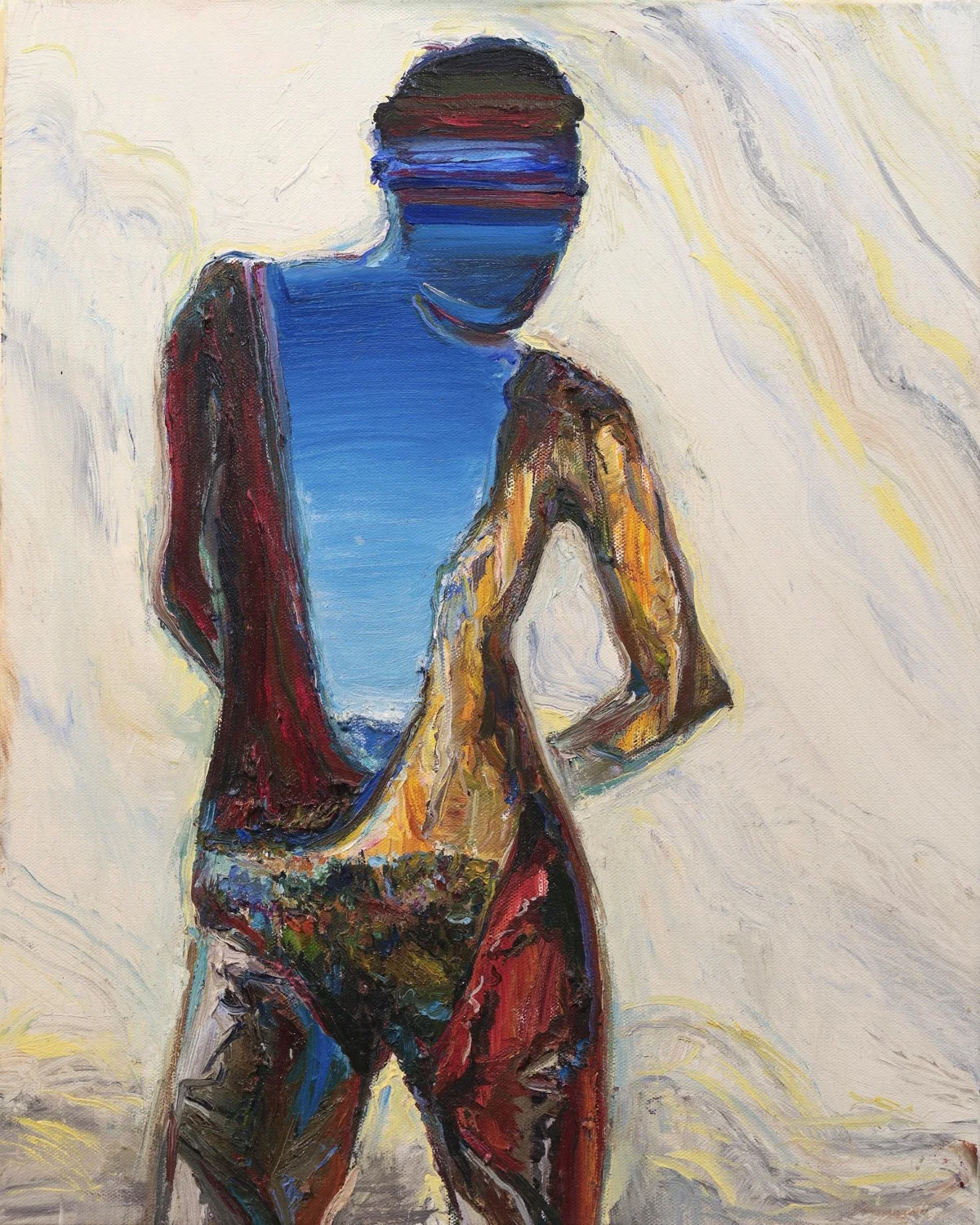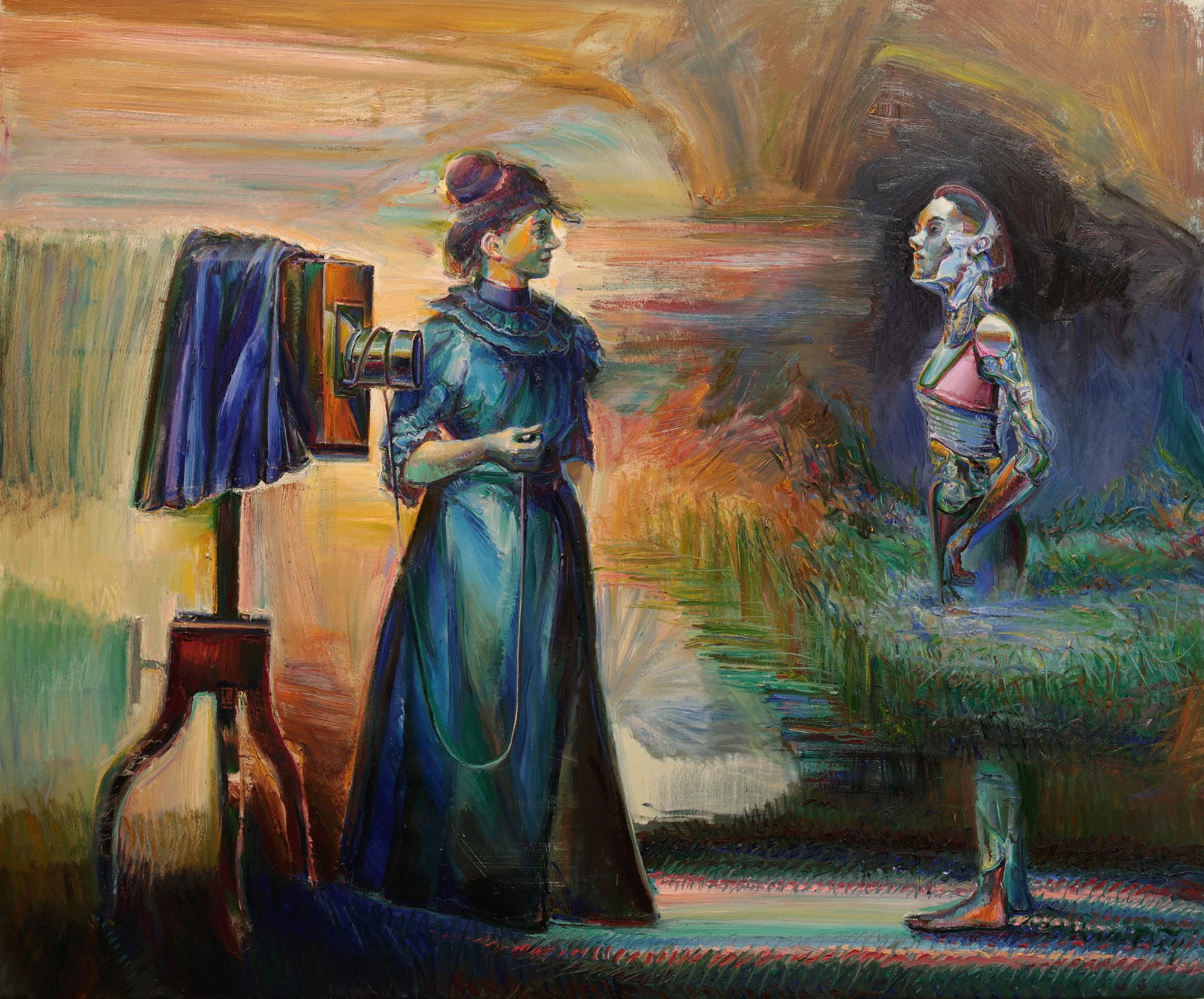Jeff Myers - Convergence Exhibition
Swirling colors and surreal blends of nature and technology define Jeff Myers’ paintings. Contrasts are at the very heart of his oeuvre. His skillful paint application leaves every purposeful brush stroke on full display, as he builds bombastic texture to define his figures. Harnessing the power of complementary colors, he demonstrates a keen ability to build eye-catching compositions rife with pops of color. The various shades of blues (particularly in the indigo, ultramarine, and Phthalo families) are present in almost all paintings in Myers’ newest exhibition Convergence. In some, such as The Journey, these serve as the complements that emphasize the warmer colors that imply an emanating light.
In others, such as The Photographer, his entire composition is done in these rich shades. Almost as if he is exploring the very concept of the color blue, this work presents the various tones to best offset one another.
This expertise over color comes as no surprise given Myers’ history of studying with one of the great modern masters of color theory, Wayne Thiebaud. As a teenager, Myers struggled in traditional educational settings, and he instead began to take college art classes at local schools throughout his native Sacramento region. His early interactions with Thiebaud at UC Davis gave him a mentor and life-long friend whose influence on Myers’ style is undeniable. Their shared interests in brushy application and the emphasis of high-key color palettes distinguishes their paintings. The detail of Thiebaud’s Irrigation Pond from 1995/2015 and Myers’ Horizons shares similar layering and juxtapositions of contrasting colors to achieve poignancy.
Myers’ earliest works were directly inspired by his parents’ mutual profession as photographers. As Myers recalls, “One day we would be photographing a cotton gin and the next a protest for migrant farm workers rights at the state capitol.”His exposure to the diverse and social and economic groups across California led him to an early body of work that focused on American sub-cultures and class differences. His style at that time took in Thiebaud’s influence, but also reflected his fascination with art history, notably the “staccato frequency of [the Italian Futurist] Boccioni [and] the scale and subject matter of [the Mexican Muralist] Siqueiros.” His heroic depictions of laborers reflects the respect he gives these long-ignored figures.
Myers found early success shortly after those early days studying with Thiebaud and in developing his distinctive subject matter. He began exhibiting in Sacramento in group shows at only 15, and by the age of 19, he earned a solo painting exhibition. Not long after, Myers relocated to New York City, in the Greenpoint neighborhood of Brooklyn. In this new environment, Myers explored new media with a fervor that earned him exhibitions there too. His three-dimensional relief constructions would influence his paintings, which eventually came to incorporate collage and mixed media, such as in Moon Light Tractor.
His experiences in New York City in the 1990s were powerful, and emmeshed him in the world of high art. Yet, his disinterest in the prevailing minimalist and conceptualist trends of the day made it a difficult environment in which to find his true voice. Throughout his years living in Brooklyn, his frequent trips to Sacramento continued to remind him of the atmosphere and environment that served as a constant source of inspiration. His love for the American West was deeply engrained deriving from the collection of over 700,000 slides his parents amassed with the guidance of Ansel Adams. The agricultural settings of Northern California held continual sway over his inner vision. His adventures across the state and his airplane and helicopter flights to gain aerial perspectives of the farmland, city grids, rail yards, mines, and recycling plants provide him with ripe imagery upon which to draw.
In returning full-time to the freedoms of California, where artists have long marched to the beat of their own drums, Myers was able to continue his explorations of paintings bursting with color and figures. Early on after his return, Myers developed his Bodyen Series in which he projected his photograph of the local agricultural landscapes on human bodies – flesh becoming the screen. This concept of duality, of containing imagery of landscapes within the bounds of the human figure perpetuates in Myers’ work today. His new work Yosemite is a direct response to that series, as he depicts the iconic vistas of the valley upon the surface of the human form. The figure adopts the identity of this famous location, becoming an anthropomorphized embodiment. This repeated depiction of the natural world and the figure is a hallmark in Myers collection of paintings, and it gives him the ability to interweave these discreet themes while building narrative.
Of all themes that run throughout his paintings, technology runs as a pervasive current. His blending of past, present, and future, lead to surprising juxtapositions. In particular, works such as Self Portrait unexpectedly blend subjects including an antique camera, a Victorian-era ensemble, and a futuristic cyborg figure. The title’s indication of the woman capturing a self-portrait adds a deeper narrative element that allows these disparate, anachronistic elements to fuse.
This large-format composition is far from the only work that features cameras. Rather, different styles of cameras from throughout photographic history appear in Myers’ narrative works. On occasion, they even become the primary subject, such as in Her Camera World, in which a narrative unfolds within the borders of a camera.
Following in his parent’s footsteps, Myers has had his own successful career as a photographer. His images have appeared in numerous publications including National Geographic, National Wildlife, Animals Magazine of London, Terre Sauvage, and the New York Times. His consummate love for this medium and his dynamic time behind the lens comes across in this newest group of works, and he repeatedly pays homage to the camera.
In this newest exhibition, on view from August 27 – September 27, 2025, Myers successfully brings together his diverse interests in his quintessential style. All together, his paintings prompt viewers to look at details closely and to appreciate the dichotomies of life.

